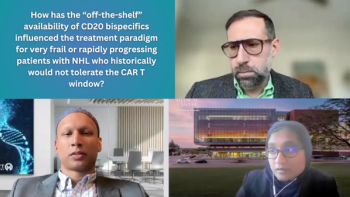
Where Is Targeted Therapy for AML Heading?
Development of targeted therapies for acute myeloid leukemia (AML) represents an ongoing challenge for the field. There is substantial promise, however, in several different approaches to targeted AML therapy, including IDH inhibitors, FLT3 inhibitors, and others.
Development of targeted therapies for acute myeloid leukemia (AML) represents an ongoing challenge for the field. There is substantial promise, however, in several different approaches to targeted AML therapy, including IDH inhibitors, FLT3 inhibitors, and others. Two experts spoke about this field at the 11th Annual National Comprehensive Cancer Network (NCCN) Hematologic Malignancies Congress, held September 30–October 1 in New York.
“AML genomes have fewer mutations than most other adult cancers,” said Richard M. Stone, MD, of the Dana-Farber Cancer Institute in Boston. There are only about 13 such mutations, and only 5 of those are considered pathophysiologically relevant to the disease. Among the categories of mutation are alterations to DNA methylation-related genes, tumor suppressor genes such as p53, chromatin-modifying genes, and others.
At present, only a few genes are considered key for prognostic information at the time of an AML workup. These includes FLT3 internal tandem duplication (ITD) and KIT mutations, which are considered unfavorable, and NPM1 and CEBPA mutations, which are considered favorable. Given this genomic landscape at the current time, Stone said, certain approaches to targeted therapy are particularly promising.
FLT3 is mutated in 25% to 30% of AML patients, Stone said. A number of FLT3 inhibitors have been tested, including midostaurin, sorafenib, and others. The newest such agent, gilteritinib, is active against both the FLT3 ITD and the FLT3-D835 mutation, though in one study patients with the FLT3 ITD only had an overall response rate of 56%.
More trial experience has accrued with midostaurin. “It works somewhat as a single agent, but we thought it might be a good idea to combine it with chemotherapy, to see if we could potentiate the impact of chemotherapy on patients with a FLT3 mutation,” Stone said. The CALGB 10603 trial was the result, which randomized 717 AML patients with FLT3 mutations to either midostaurin and chemotherapy or placebo and chemotherapy.
Though Stone said the remission rates were somewhat lower in the trial than expected, there was a 23% reduction in the risk of death with midostaurin. The 4-year survival rate was 51.4%, compared with 44.2% with placebo. The drug should be considered the new standard of care for newly diagnosed patients between ages 18 and 60 with FLT3 mutations.
Another target for AML therapies is CD33. “CD33 is expressed on blasts from over 90% of patients who have AML,” Stone said. “It’s a good target.” There are anti-CD33 antibodies in development, such as vadastuximab, but there are also existing drugs such as gemtuzumab that target CD33; approved in 2001, gemtuzumab was then withdrawn in 2010 due to liver toxicity. Stone said that drug on its own “is not a home run,” but work is ongoing on combinations with gemtuzumab that may “resurrect” the drug.
Jessica K. Altman, MD, of the Robert H. Lurie Comprehensive Cancer Center at Northwestern University in Chicago, spoke about other targeted options including IDH and BCL-2 inhibitors.
There are three isoforms of IDH mutation, though IDH1 and IDH2 are most concerning with regard to AML, she said. Two IDH inhibitors in development, AG120 and AG221, have shown promising response rates based on early data.
Another promising agent is venetoclax, a BCL-2 selective inhibitor. BCL-2 overexpression sequesters pro-apoptotic proteins, allowing cancer cells to evade apoptosis. Venetoclax binds to BCL-2 allowing apoptosis to resume proper function.
A phase II study of the drug in relapsed/refractory AML (or patients unfit for chemotherapy) found an overall response rate of 19%. Another study, a combination trial of venetoclax and low-dose cytarabine in patients with a median age of 75 years, had a promising remission rate of 54%. Yet another phase Ib study in combination with hypomethylating agents had a remarkable complete remission rate of 71%. Altman noted that this was not yet randomized data, but called these early studies “very interesting.”
Altman said she anticipates a paradigm shift in the future of AML treatment, whereby clinicians can offer hypomethylating agents along with targeted therapies even in patients deemed fit for chemotherapy. So far, though, she cautioned that “we are far from having the data.” She also said it is possible that we will recognize certain forms of AML that may be entirely dependent on one mutation (as is the case with chronic myeloid leukemia), allowing some patients to forego transplant or otherwise transform treatment.
Newsletter
Stay up to date on recent advances in the multidisciplinary approach to cancer.


















































































